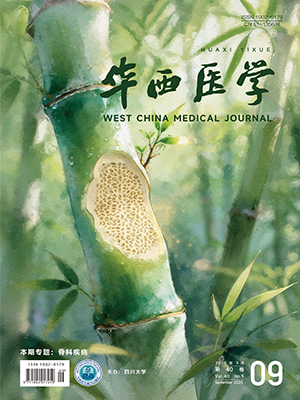| 1. |
Akhoundi A, Singh B, Vela M, et al. Incidence of adverse events during continuous renal replacement therapy. Blood Purif, 2015, 39(4): 333-339.
|
| 2. |
Shingarev R, Wille K, Tolwani A. Management of complications in renal replacement therapy. Semin Dial, 2011, 24(2): 164-168.
|
| 3. |
Silversides JA, Pinto R, Kuint R, et al. Fluid balance, intradialytic hypotension, and outcomes in critically ill patients undergoing renal replacement therapy: a cohort study. Crit Care, 2014, 18(6): 624.
|
| 4. |
Shawwa K, Kompotiatis P, Jentzer JC, et al. Hypotension within one-hour from starting CRRT is associated with in-hospital mortality. J Crit Care, 2019, 54: 7-13.
|
| 5. |
凌琳, 趙振華, 仇麗華, 等. 重癥患者連續性腎臟替代治療低血壓發生率的影響因素. 護士進修雜志, 2021, 36(11): 1048-1052.
|
| 6. |
李晶. 急性腎損傷病人連續性腎臟替代治療期低血壓發生危險因素及預防護理研究. 全科護理, 2022, 20(13): 1836-1839.
|
| 7. |
付平. 連續性腎臟替代治療的并發癥. 中華醫學會腎臟病學分會 2007 年學術年會論文集. 2007: 151-153.
|
| 8. |
Douvris A, Malhi G, Hiremath S, et al. Interventions to prevent hemodynamic instability during renal replacement therapy in critically ill patients: a systematic review. Crit Care, 2018, 22(1): 41.
|
| 9. |
Robert R, Méhaud JE, Timricht N, et al. Benefits of an early cooling phase in continuous renal replacement therapy for ICU patients. Ann Intensive Care, 2012, 2(1): 40.
|
| 10. |
Rokyta R Jr, Matejovic M, Krouzecky A, et al. Effects of continuous venovenous haemofiltration-induced cooling on global haemodynamics, splanchnic oxygen and energy balance in critically ill patients. Nephrol Dial Transplant, 2004, 19(3): 623-630.
|
| 11. |
Santiago MJ, López-Herce J, Urbano J, et al. Complications of continuous renal replacement therapy in critically ill children: a prospective observational evaluation study. Crit Care, 2009, 13(6): R184.
|
| 12. |
Davenport A, Will EJ, Davidson AM. Improved cardiovascular stability during continuous modes of renal replacement therapy in critically ill patients with acute hepatic and renal failure. Crit Care Med, 1993, 21(3): 328-338.
|
| 13. |
John S, Eckardt KU. Renal replacement therapy in the treatment of acute renal failure-intermittent and continuous. Semin Dial, 2006, 19(6): 455-464.
|
| 14. |
Schneider AG, Bellomo R, Bagshaw SM, et al. Choice of renal replacement therapy modality and dialysis dependence after acute kidney injury: a systematic review and meta-analysis. Intensive Care Med, 2013, 39(6): 987-997.
|
| 15. |
Wald R, Shariff SZ, Adhikari NK, et al. The association between renal replacement therapy modality and long-term outcomes among critically ill adults with acute kidney injury: a retrospective cohort study. Crit Care Med, 2014, 42(4): 868-877.
|
| 16. |
Bell M, SWING, Granath F, et al. Continuous renal replacement therapy is associated with less chronic renal failure than intermittent haemodialysis after acute renal failure. Intensive Care Med, 2007, 33(5): 773-780.
|
| 17. |
Kitchlu A, Adhikari N, Burns KE, et al. Outcomes of sustained low efficiency dialysis versus continuous renal replacement therapy in critically ill adults with acute kidney injury: a cohort study. BMC Nephrol, 2015, 16: 127.
|
| 18. |
Uchino S, Bellomo R, Morimatsu H, et al. Continuous renal replacement therapy: a worldwide practice survey. The beginning and ending supportive therapy for the kidney (B. E. S. T. kidney) investigators. Intensive Care Med, 2007, 33(9): 1563-1570.
|
| 19. |
Kelly YP, Sharma S, Mothi SS, et al. Hypocalcemia is associated with hypotension during CRRT: a secondary analysis of the acute renal failure trial network study. J Crit Care, 2021, 65: 261-267.
|
| 20. |
Manns M, Sigler MH, Teehan BP. Intradialytic renal haemodynamics--potential consequences for the management of the patient with acute renal failure. Nephrol Dial Transplant, 1997, 12(5): 870-872.
|
| 21. |
Kim IB, Fealy N, Baldwin I, et al. Circuit start during continuous renal replacement therapy in vasopressor-dependent patients: the impact of a slow blood flow protocol. Blood Purif, 2011, 32(1): 1-6.
|
| 22. |
石敏. CVVHD 相關性低血壓的原因分析及護理措施. 齊齊哈爾醫學院學報, 2009, 30(1): 107-108.
|
| 23. |
Sigwalt F, Bouteleux A, Dambricourt F, et al. Clinical complications of continuous renal replacement therapy. Contrib Nephrol, 2018, 194: 109-117.
|
| 24. |
Lobo SM, Salgado PF, Castillo VG, et al. Effects of maximizing oxygen delivery on morbidity and mortality in high-risk surgical patients. Crit Care Med, 2000, 28(10): 3396-3404.
|
| 25. |
Pulimood TB, Park GR. Debate: albumin administration should be avoided in the critically ill. Crit Care, 2000, 4(3): 151-155.
|
| 26. |
Mc Causland FR, Waikar SS. Association of predialysis calculated plasma osmolarity with intradialytic blood pressure decline. Am J Kidney Dis, 2015, 66(3): 499-506.
|
| 27. |
Fernández S, Santiago MJ, González R, et al. Hemodynamic impact of the connection to continuous renal replacement therapy in critically ill children. Pediatr Nephrol, 2019, 34(1): 163-168.
|
| 28. |
胡軍濤, 李超乾, 湯展宏. 琥珀酰明膠注射液快速輸注對低血容量性休克患者血清電解質及凝血功能的影響. 廣西醫科大學學報, 2013, 30(1): 55-57.
|
| 29. |
Roberts JS, Bratton SL. Colloid volume expanders. Problems, pitfalls and possibilities. Drugs, 1998, 55(5): 621-630.
|
| 30. |
Edwards JD, Nightingale P, Wilkins RG, et al. Hemodynamic and oxygen transport response to modified fluid gelatin in critically ill patients. Crit Care Med, 1989, 17(10): 996-998.
|
| 31. |
王珊娟, 杭燕南, 龔國慶, 等. 血定安對機體血流動力學和血生化影響. 中華麻醉學雜志, 1996, 16(8): 363-365.
|




